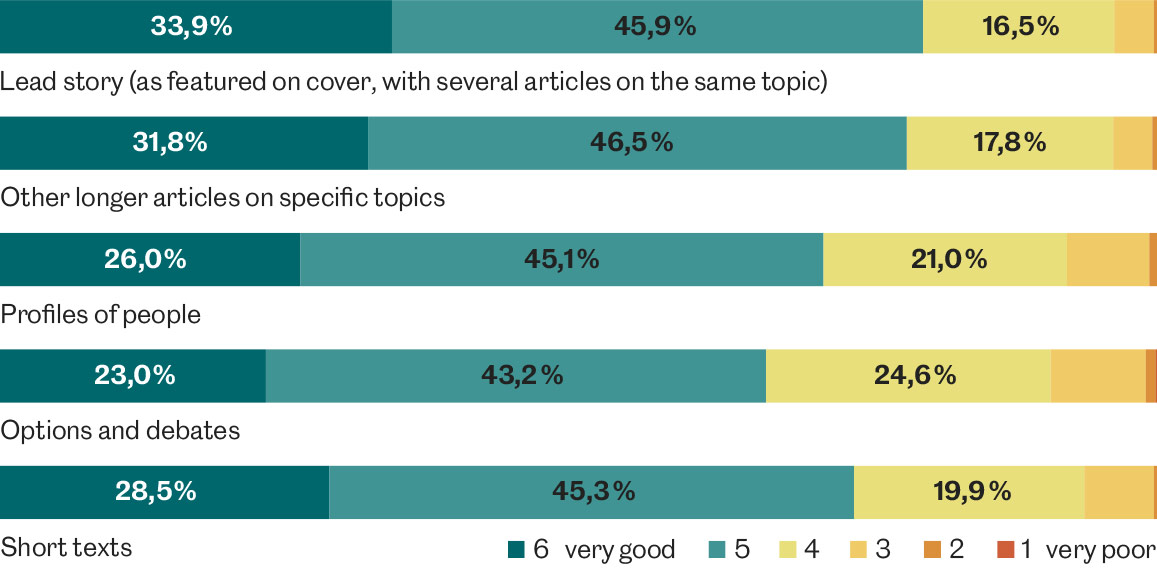Reader survey
We know what you’re thinking!
Roughly 1,600 of our readers took part in our survey of June 2023. We learned that they basically like Horizons the way it is. But it’s worth taking a closer look at what everyone said.

This is how you judged our different columns. You can find the complete evaluation of our survey here. | Graphic: Jörg Schneider
“I’d like one thing above all for Horizons: that even more people read it”. This is the opinion of one of our readers from the survey we conducted back in June 2023. Overall, the roughly 1,600 people who took part gave Horizons a score of 5.25 on a scale from 1 to 6. So we not only passed the test, but got what in the Swiss education system is regarded as a grade between ‘good’ and ‘very good’. Even when compared to the well-known, grander science magazines such as New Scientist in the UK, Spektrum der Wissenschaft in Germany and Science et vie in France, readers generally gave Horizons a better rating.
The participants’ favourite articles in the magazine are in its ‘Feature’ section. In the issue you’re reading right now, that means the lead story and the articles in the dossier ‘The tourism of the future’. Our long background articles are almost as popular – in the present issue, for example, the article on the Gulf Stream falls into that category. Almost 80 percent of participants give these two formats a grade of between 5 and 6, and almost two thirds read them almost every time. Our readership also likes the portraits and the debates, but slightly less than the previously mentioned categories. For us in the editorial team, this means we have to keep up the good work on the main topics, and put more effort into the portraits and debates!
People’s prime motivation for reading Horizons seems to be a desire to get an overview of what’s happening in the world of science and scholarship. Some want to know what the latest trends are, and read about recent research findings. For many, reading a research magazine is simply a stimulating way of passing the time. Incidentally, the print version – available in French and German – is much more popular than the online versions, even among our youngest readers. And this provides us with further justification in continuing to devote just as much attention to our printed offerings. One survey participant wrote: “I hope that the print version will keep going – it’s a highlight in an everyday world that is otherwise dominated by screens!”
Younger readers tend to be women
We also wanted to get to know our readership better. Our survey revealed that the average reader of Horizons is male, Swiss-German, 56 to 65 years old, a natural scientist with a doctorate but not a postdoctoral habilitation, and currently active in research. But the magazine has also made headway with women. When looking at the younger participants in our survey, the number of women readers is higher. Above the age of 66, men clearly dominate our readership; but among those under 45, men and women are represented equally. Overall, the proportion of women among our readers has risen from 32 to 39 percent since our last survey in 2014. In recent decades, women have overall caught up with men when it comes to university education, with the 2022 figures from the Federal Statistical Office showing that women have in fact taken the lead. This is probably now also making itself felt in the composition of our readership.
The readers of Horizons are also very well educated: since the last survey, the number of readers with a university degree has risen from 76 to 83 percent, and four out of ten readers have a doctorate or higher. And here, too, the figures from the Federal Statistical Office can provide a possible explanation. The proportion of the population with a university education rose from 21 to 30 percent between 2010 and 2022. But we will nevertheless take to heart the feedback we got from one particular participant in the latest survey, who suggested that “some articles could be a bit more layman-friendly”.




